- Pact swap has launched a production version that enables bridgeless cross-chain swaps of native assets.
- The platform claims users can enjoy up to 95% lower costs than competing cross-chain DEXs.
- Pact Swap's cost savings are achieved by eliminating intermediaries such as bridge relayers and custom validators.
pact swap has launched a production version, allowing bridgeless cross-chain swaps of native assets on the main blockchain.
The platform claims users can enjoy up to 95% lower costs than competing cross-chain DEXs.
This migration follows a period of live testing during which Pact Swap executed thousands of swaps including Bitcoin, Ethereum, BNB Chain, Tron, Litecoin, Dogecoin, Polygon, and more.
The platform's order book model, which is valuable even for single-chain routes, is up to 45% more cost-effective than similar systems.
Cost reduction through protocol design
Pact Swap's cost savings are achieved by eliminating intermediaries such as bridge relayers and custom validators.
The system can perform swaps natively without wrapping assets, thus ensuring a significant change in operational overhead.
PACT framework use coinweb's Reactive smart contracts. Validate cross-chain transactions based on consensus from the origin and destination chains.
This allows swaps to be made without relying on intermediary counterparties while providing secure deterministic execution and tight collateralization.
All trades are based on a 2x overcollateralization system, which automatically pays out to counterparties in the event of a failed delivery.
The simplified architecture is less complex and more stable, while allowing for configurability and permissionless listings for decentralized exchanges (DEXs).
Bridgeless Bitcoin operations and modular payments
Pact Swap is a cross-chain DEX that performs on-chain cross-chain payments between Bitcoin and EVM-compatible blockchains without relying on synthetic or wrapped assets.
This also maintains on-chain validation guarantees and enables improved and seamless interoperability between ecosystems.
To solve universal problems such as lack of sufficient collateral capacity and layer 1 congestion, Pact Swap introduces a modular payment form.
Such use cases include peer-to-peer Dustlock UTXOs, multi-signature Bitcoin vaults, Lightning Network payments, decentralized exchange integrations, and NFT-based payments.
This resiliency helps scale liquidity sources while reducing overall network fragmentation.
Positioning between cross-chain DEXs
Pact Swap is entering a field crowded with competitors such as THORChain and Chainflip, which first created a boom among these native Bitcoin swaps.
However, validator-centric models also introduce additional costs and operational overhead due to lower TPS.
However, the Pact Swap implementation is bridgeless, allowing for native BTC swaps using a collateral system designed to provide high security procedures with minimal capital costs.
The recent Dogecoin and Polygon integration brings the total number of supported networks to 7, with Solana and Base expected to join soon.
A permissionless listing of assets on these and other chains allows anyone to add liquidity while allowing teams to spin up pairs without approval.
Targeted liquidity concentrates depth on congested routes, reduces slippage and tightens spreads
Integration and market outlook
pact swap integrates with top DEX aggregators, allowing wallets and trading interfaces to route transactions through the native BTC path by default.
The integration should also increase exposure and usage as order flow from the current decentralized ecosystem is directed towards on-chain and cross-chain solutions.
Assuming current levels of economics and performance persist, Pact Swap has the potential to become a true alternative to existing cross-chain infrastructure as a low-cost composable swap attachment point with native asset support.

